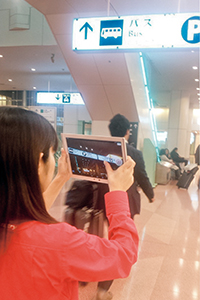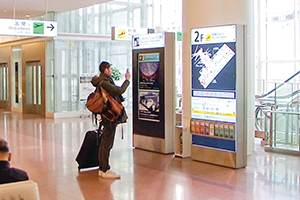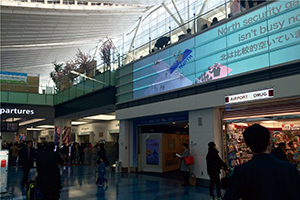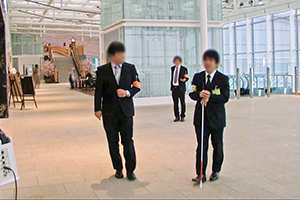 |
|||||||||||
|
|
|||||||||||
|
Feature Articles: NTT Group Activities in the Transportation Field Vol. 14, No. 7, pp. 5–11, July 2016. https://doi.org/10.53829/ntr201607fa2 Joint Experiment on Enhancement of Information Universal Design at AirportsAbstractIt is necessary to further improve barrier-free mobility and accessibility to information at international airports, which serve as gateways for visitors from abroad. Of course, airports also provide opportunities to publicize Japan’s cutting-edge technologies to the world. This article introduces a joint experiment conducted at Haneda Airport by NTT and Tokyo International Air Terminal Corporation with a view to enhancing information universal design in air terminals. Keywords: airport, information universal design, accessibility 1. IntroductionThe Haneda Airport International Passenger Terminal (hereinafter “international terminal”) has adopted user-participation type universal design since the design stage. The universal design for this international terminal is top-notch from both hardware and software perspectives. Universal design is socially integrated with human diversity. With the rapid increase in the number of international visitors to Japan and the dramatic growth in the number of international flights in recent years, the current hardware and software capacities of the terminal are expected to be exceeded in the near future. Further efforts are therefore required in order to provide multilingual services and reduce congestion. Since its inception, Haneda Airport’s Universal Design Study Committee has studied and implemented improvements in the international terminal every two years. In the latest meeting of the committee, some members urged further utilization of information and communication technology (ICT) because it is difficult to resolve issues through the conventional means of fixed information boards and face-to-face provision of guidance. A new generation of ICT techniques is required in order to improve accessibility and enhance customer experience. 2. Joint experiment to enhance information universal design at airportsIn light of the above conditions at Haneda Airport, the world’s first joint experiment to enhance information universal design was carried out in Haneda’s international terminal from December 2015 through March 2016, using cutting edge information technologies encompassing sound, light, images, and wireless communication. The experiment was aimed at improving accessibility for overseas visitors and generally enhancing universal design, with a particular focus on assisting international visitors, wheelchair and baby stroller users, and seniors to enjoy better mobility both within and out of the terminal. 3. NTT’s feasibility testIn view of the needs to 1) support multiple languages and cultures, 2) optimize guidance for easy mobility, and 3) support seniors and persons with disabilities in airports, train stations, streets, and public areas such as stadiums as we approach 2020, NTT believes that it is necessary to adopt ICT solutions in addition to the conventional physical measures. To this end, NTT has been studying the provision of innovative hospitable user interface (UI) and user experience (UX) by exploiting cutting-edge technologies such as sound, image analysis, and big data analysis. As part of the joint experiment, NTT carried out a feasibility test at Haneda Airport in an effort to resolve the above-mentioned issues. Specifically, the following three experiments were conducted to evaluate the effectiveness of the technologies used to enhance information universal design and to identify issues to be addressed before these services are actually introduced. 4. Information provision through pointing UI made possible using image processing technologyWe developed a UI that involves pointing actions to help visitors find the information they need. We describe here the UI and the technical issues involved. 4.1 ProblemsFor visitors from abroad, linguistic and cultural differences relating to mobility and food services in strange places can be very stressful. In particular, in an airport, which is the first place they experience on arrival, they may encounter a number of problems. For example, they may find that most information boards are written only in Japanese, English, and one or two other major languages. Also, they might hesitate to go inside a shop or restaurant because they cannot imagine what the shop or restaurant is like, or they cannot easily find any way of checking the ingredients of Japanese dishes with which they are not familiar. 4.2 Overview of experimentIn light of these issues, NTT has been developing technology that enables users to easily obtain useful information through only intuitive actions. NTT has developed angle-free object search technology [1] that offers a UX in which the user can obtain appropriate and useful information by simply pointing the camera of his/her smartphone at a sign/information board in the arrival hall, or at shops, food dish samples, or products in the commercial area of the air terminal. The objectives of this experiment were to evaluate the effectiveness of this UX and to identify issues to be addressed in order to improve image recognition accuracy in real fields, and issues related to commercial service introduction (Photo 1).
In fiscal year 2015, we conducted a field survey on information needs at airports with users from abroad (English or Chinese speakers). We asked when and where respondents had experienced information accessibility problems, what kinds of information they were seeking, what means of information search they used, and the extent to which they obtained information in each of the following five categories: transportation, telecommunications, food, shopping, and others. The objective was to obtain quantitative data on needs and find some use cases for utilization in our future service design work. In addition, we asked respondents to actually try the pointing UI in order to obtain data about how they pointed their smartphones at objects (what actions they took to point their smartphones and from what angles objects were photographed). Since the current design of the UX of the pointing UI is based on the typical pointing actions of Japanese users, we plan to use the obtained data when we design the UX of applications that are intended for visitors from abroad (Photo 2).
4.3 Technical pointsAngle-free object search technology automatically recognizes an object from an image captured by a camera. When one or just a few photos of an object are taken from the front and from oblique angles and registered in a database in advance, this technology can recognize the object from a photo with a high degree of accuracy, even if it has been photographed from a different angle, or even if parts of the object are hidden. One advantage of this technology is that it can be implemented at low cost because it requires no installation work in the surrounding facilities. 5. Guidance of pedestrian flow using dynamic signs based on big data analysisAnother area we wanted to improve was how pedestrians are guided in public areas. 5.1 ProblemsThe number of visitors from abroad has been increasing every year, exceeding 16 million as of October 2015 [2]. As a result, the congestion at airports is continuing to increase. There is an urgent need to solve this problem. 5.2 Overview of experimentNTT is studying a way to optimally guide pedestrian flow to help people avoid congested areas by foreseeing future degrees of the constantly changing congestion state and dynamically altering direction signs accordingly. NTT will trial a dynamic display of direction signs in places where people tend to congregate such as the departure hall or passport control area in order to identify the best ways of presenting information (notations, color, timing, etc.) and also to verify the effectiveness of presenting information visually for hearing-impaired persons in cases where only audio announcements have conventionally been made, such as in cases of emergency. In fiscal year 2015, we trialed a display of direction signs using projection mapping and observed congestion states in two use cases: in the arrival hall on the second floor and in the passport control area in the departure hall on the third floor (Photo 3). In this trial, we developed a hypothesis for congestion reduction from observing people’s behavior. On the basis of the hypothesis, we designed signs that reflected universal design and evaluated the effectiveness of the information and direction signs, both qualitatively and quantitatively, by projecting these signs in the real field.
For the qualitative evaluation in the real field, we used three representation patterns: 1) superimposing information in a manner similar to augmented reality, which was aimed at enhancing visual attraction, 2) projecting animation of existing pictorial signs, which was aimed at enhancing visual attraction and increasing the volume of information that can be presented, and 3) simply projecting still images of existing signs. We identified issues regarding the formulation of a universal design standard by interviewing more than 100 domestic and international (English or Chinese speaking) visitors to get their evaluations of the above signs from four aspects: visual attractiveness, visibility, understandability, and stimulus for behavior change. For the qualitative evaluation, we measured the effect of the guidance using dynamic sign projection on pedestrian flow by counting the number of people who passed through and the number who stayed (number of people in queues, etc.) in respective places for a case where projection mapping was employed and for a case where it was not. The results obtained will be used as parameters in ongoing simulations. 5.3 Technical pointsWe aim to achieve a proactive form of guidance using new dynamic signs in order to predict potential congestion and to prevent it from occurring. This guidance combines the pedestrian flow simulation using the spatio-temporal multidimensional collective data analysis technology [3] being developed by NTT and projection mapping, which allows flexible projection of information. 6. Intelligibility enhancement sound signs using voice processing technologyWe are also exploring the use of ICT to assist visually impaired people. The premise of the system is explained here. 6.1 ProblemsAirports and train stations support the mobility of visually impaired people by providing information using systems designed for senses other than sight. A typical example is a sound sign that provides voice guidance to assist people in restrooms or on escalators, as well as acoustic guidance in other places. Sound signs are provided in accordance with the barrier-free environment guidelines developed by the Ministry of Land, Infrastructure, Transport and Tourism. Although they are very useful, they are not sufficiently widespread because of physical restrictions or high ambient noise levels in potential installation sites. 6.2 Overview of experimentsThe intelligent sound sign proposed by NTT has two features. One is that it uses a speech intelligibility enhancement technique to provide guidance even under ambient noise. The other feature is that it switches to the user’s mother tongue when the user approaches places where the guidance is needed. It utilizes voice guidance devices, access points, beacons, and the user’s smartphone. With this system, we intend to realize a society in which the visually impaired can more easily utilize public facilities such as airports and train stations. In fiscal year 2015, we conducted experiments with the participation of visually impaired subjects. In test environments that replicated the background sounds often heard at an airport (e.g., the sounds of suitcases being rolled), the subjects heard a voice guidance message produced using the synthesized speech intelligibility enhancement technology [4] developed by NTT as well as a guidance message conveyed using the conventional sound sign approach. We compared the subjects’ comprehension levels for the respective sound sources in terms of how well the speech was conveyed (standing next to the sound source) and how the distance from the sound source affected comprehension (standing some distance from the sound source) (Photo 4).
The system we developed and experimentally evaluated in fiscal year 2015 is a sound sign system that works with voice guidance devices, commercial smart watches, and smartphones. The experiment was conducted with visually impaired subjects to evaluate the system’s usability. In this experiment, guidance to a restroom at the airport was taken as the use case. We evaluated the system’s effectiveness for mobility support and identified issues to be addressed prior to commercial introduction (Photo 5).
6.3 Technical pointsThe speech intelligibility enhancement technique measures ambient sounds and adjusts the tonal characteristics of the voice relative to that of the background sounds so as to emphasize speech clarity. Therefore, voice guidance can be heard clearly, even in noisy surroundings. 7. Future developmentNTT and Tokyo International Air Terminal Corporation are working on improving information universal design by participating in the Committee to Study Information UD (universal design) at Airports (Chair: Professor Tetsuo Akiyama, Chuo University), established in November 2015. On the basis of the results of the joint feasibility test described in this article, we will develop and introduce the technologies outlined here and also develop new technologies as we approach 2020. We will also invite other airports and enterprises to participate in joint experiments as new partners. References
|
|||||||||||

















